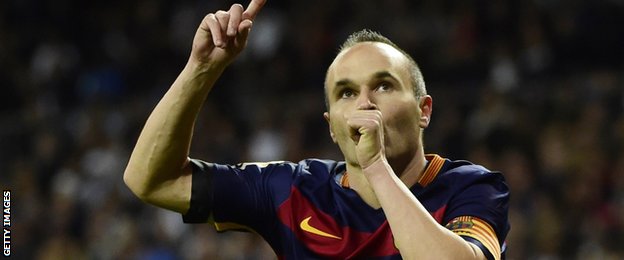 |
| Luis Suarez scores for Barcelona in Saturday night's clásico. ESPN photo. |
Barcelona whomped Real Madrid, 4-0, in what was supposed to be a close match, but that was almost beside the point.
 |
| Ronaldo and Real Madrid had a rough night. Getty Images via BBC |
But their matches--which have so much history and drama that they are referred to as clásicos--regularly draw hundreds of millions of TV viewers.
First, the teams are rich and successful. Forbes ranks Barcelona and Real Madrid as the two most valuable sports franchises in the world. The BBC last year recounted the history of the 200-plus clásicos, and gave a sense of why they deserve the designation as classics. Similar to the Patriots-Giants or Red Sox-Yankees rivalries, but bigger.
Pre-game estimates for Saturday's match were 600 million viewers in 170 countries (Spain's population is 45 million), or more than six times the TV audience for the last Super Bowl, according to CNN. A 2014 match between the two teams drew 400 million viewers.
 |
| Iniesta had a brilliant goal for Barcelona. Getty Images via BBC |
Both teams are loaded with other world-class stars--James (pronounced HAH-mes) of Colombia, Neymar of Brazil (he notched one goal Saturday for Barça), Luis Suarez of Uruguay (he had two goals) to name a few.
Barcelona and Real Madrid are perennial champions of the 20-team league, and ESPN's soccer correspondent says Barcelona is among the best futbol teams in the world right now, if not the best. Same goes for the Spanish league itself.
An engaged crowd
These fans were beer drinkers, mainly, Cruzcampo on tap. A small draft, una caña, for about $1.90. At the bar, little torpedo sandwiches of ham and cheese or Spanish tortilla (a kind of potato omelette), about $1.25.
A middle-aged woman sitting next to us with a gravelly smoker's voice was a Madrid fan but kept her stream of obscenities and frustration at a level audible only to her friend and us. When Barcelona got away with a handball (obvious, the ref missed it) and a takedown of Ronaldo in the penalty area, both of which should have given Madrid a penalty kick, you could barely hear her groan of discontent. Otherwise, the rest of the crowd might have run her out of the place.
Boring?
I can watch an entire soccer (futbol) game, two 45-minute halves, because the action is continuous and always interesting. There are no time-outs. This match ended two hours after the 6:15pm start. But I cannot watch an entire American football game, which often stretches to three-and-a-half hours with all the clock-stopping by the coaches and lawyering by the referees.
The largely Barcelona crowd in the bar stayed all the way to the end, despite the fact that the match was over shortly after half-time. I am told that they would not have hung around if their team had been getting whomped.
In 2011, when Cindy and I spent two months traveling around Spain, there were four clásicos in 18 days as the two teams played each other in the League, the King's Cup, and the European Championship series. I managed to watch all of them. Exciting stuff.
Related:
How to spend nine weeks in Europe without losing your shirt
Columbus Day story: How he brought me to Spain
20,000-year-old cave art and the north coast of Spain
In Pamplona, they party like it's 1591
Barcelona's art and architecture make it a favorite
Cordoba's main attraction: mix of Jewish, Moorish, Christian cultures
Basque language has mysterious origins
No comments:
Post a Comment